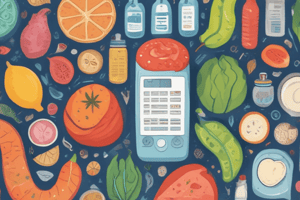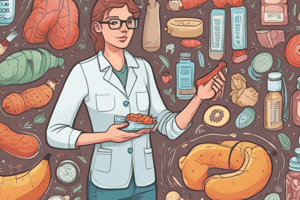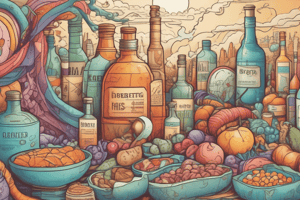Podcast
Questions and Answers
Which of the following factors is NOT included in the metabolic syndrome cluster?
Which of the following factors is NOT included in the metabolic syndrome cluster?
- Frequent urination (correct)
- Obesity with abdominal weight gain
- Atherogenic dyslipidemia
- Hypertension
What is the primary biochemical function of glucose in the body?
What is the primary biochemical function of glucose in the body?
- To form enzymes that aid digestion
- To initiate hormonal responses
- To provide energy for cellular processes (correct)
- To facilitate oxygen transport in the blood
Which syndrome is most commonly associated with an inability to regulate glucose metabolism?
Which syndrome is most commonly associated with an inability to regulate glucose metabolism?
- Chronic Fatigue Syndrome
- Thyroid Dysfunction
- Hypoglycemia
- Diabetes Mellitus (correct)
What is the increased risk of myocardial infarction associated with diabetes compared to non-diabetics?
What is the increased risk of myocardial infarction associated with diabetes compared to non-diabetics?
Which pathway is primarily responsible for the synthesis of glucose from non-carbohydrate precursors?
Which pathway is primarily responsible for the synthesis of glucose from non-carbohydrate precursors?
Insulin resistance is primarily caused by which of the following?
Insulin resistance is primarily caused by which of the following?
Which of the following symptoms is NOT typically associated with diabetes mellitus?
Which of the following symptoms is NOT typically associated with diabetes mellitus?
What is a characteristic blood glucose level that indicates hyperglycemic hyperosmolar nonketotic coma?
What is a characteristic blood glucose level that indicates hyperglycemic hyperosmolar nonketotic coma?
What glucose level is typically associated with the onset of symptoms in hypoglycemia?
What glucose level is typically associated with the onset of symptoms in hypoglycemia?
Which of the following is NOT a standard condition required for the administration of the Oral Glucose Tolerance Test?
Which of the following is NOT a standard condition required for the administration of the Oral Glucose Tolerance Test?
What glucose level, measured 2 hours after glucose ingestion during an Oral Glucose Tolerance Test, suggests diabetes mellitus?
What glucose level, measured 2 hours after glucose ingestion during an Oral Glucose Tolerance Test, suggests diabetes mellitus?
When do healthy subjects typically return to fasting glucose levels after an Oral Glucose Tolerance Test?
When do healthy subjects typically return to fasting glucose levels after an Oral Glucose Tolerance Test?
What primarily happens to glycogens in individuals during the postabsorptive (fasting) state?
What primarily happens to glycogens in individuals during the postabsorptive (fasting) state?
What stimulates the release of glucagon?
What stimulates the release of glucagon?
Which of the following statements best describes Type 1 Diabetes?
Which of the following statements best describes Type 1 Diabetes?
During which state is the insulin-to-glucagon ratio low in normal individuals?
During which state is the insulin-to-glucagon ratio low in normal individuals?
What is a major consequence of decreased insulin control in diabetic individuals?
What is a major consequence of decreased insulin control in diabetic individuals?
What characterizes the blood glucose response after a meal in a non-diabetic individual?
What characterizes the blood glucose response after a meal in a non-diabetic individual?
What is a common physiological response to fasting in individuals with diabetes?
What is a common physiological response to fasting in individuals with diabetes?
Which substance can be utilized by the heart, skeletal muscle, and liver as fuel from fatty acid breakdown?
Which substance can be utilized by the heart, skeletal muscle, and liver as fuel from fatty acid breakdown?
Which type of diabetes is most likely to result from insufficient insulin secretion and can lead to ketoacidosis?
Which type of diabetes is most likely to result from insufficient insulin secretion and can lead to ketoacidosis?
What is the primary effect of insulin on macromolecules?
What is the primary effect of insulin on macromolecules?
Which of the following hormones is classified as a hyperglycemic agent?
Which of the following hormones is classified as a hyperglycemic agent?
In individuals with Rabson-Mendenhall syndrome, which of the following is affected due to INSR gene mutations?
In individuals with Rabson-Mendenhall syndrome, which of the following is affected due to INSR gene mutations?
What is the function of glucagon in blood glucose regulation?
What is the function of glucagon in blood glucose regulation?
During fasting, which process is primarily responsible for generating glucose from proteins?
During fasting, which process is primarily responsible for generating glucose from proteins?
Which hormone has a direct stimulating effect on triacylglycerol synthesis in fat cells?
Which hormone has a direct stimulating effect on triacylglycerol synthesis in fat cells?
How does cortisol affect gluconeogenesis?
How does cortisol affect gluconeogenesis?
Which metabolic processes are inhibited by insulin?
Which metabolic processes are inhibited by insulin?
What is the main role of glucagon in the body?
What is the main role of glucagon in the body?
Which of the following statements about Type 2 Diabetes (T2D) is true?
Which of the following statements about Type 2 Diabetes (T2D) is true?
What can lead to the development of secondary diabetes?
What can lead to the development of secondary diabetes?
What defines Impaired Glucose Tolerance (IGT)?
What defines Impaired Glucose Tolerance (IGT)?
What is a common reason for the occurrence of Gestational Diabetes (GD)?
What is a common reason for the occurrence of Gestational Diabetes (GD)?
Which of the following is NOT typically considered a complication of diabetes?
Which of the following is NOT typically considered a complication of diabetes?
Which of the following is associated with a higher risk of hyperlipidemia in Type 2 Diabetes?
Which of the following is associated with a higher risk of hyperlipidemia in Type 2 Diabetes?
What is a significant cause of diabetic ketoacidosis?
What is a significant cause of diabetic ketoacidosis?
What is the most common progression of gestational diabetes after pregnancy?
What is the most common progression of gestational diabetes after pregnancy?
Which of the following statements about diabetic complications is accurate?
Which of the following statements about diabetic complications is accurate?
What is a characteristic outcome of impaired glucose tolerance?
What is a characteristic outcome of impaired glucose tolerance?
Flashcards
Metabolic Syndrome
Metabolic Syndrome
A group of metabolic conditions associated with increased risk for cardiovascular disease, diabetes, and stroke. It involves insulin resistance, abdominal obesity, atherogenic dyslipidemia, hypertension, thrombosis, and inflammation.
Diabetes Mellitus
Diabetes Mellitus
A disorder where the body either doesn't produce enough or doesn't effectively use insulin, a hormone that regulates blood sugar. This leads to high blood glucose levels.
Glycolysis
Glycolysis
A process where glucose is broken down into pyruvate, generating energy in the form of ATP. This is the first step in glucose metabolism.
Glycogenesis
Glycogenesis
Signup and view all the flashcards
Glycogenolysis
Glycogenolysis
Signup and view all the flashcards
Gluconeogenesis
Gluconeogenesis
Signup and view all the flashcards
Insulin Signaling Pathways
Insulin Signaling Pathways
Signup and view all the flashcards
Rabson-Mendenhall Syndrome
Rabson-Mendenhall Syndrome
Signup and view all the flashcards
Hormonal Regulation of Glucose Metabolism
Hormonal Regulation of Glucose Metabolism
Signup and view all the flashcards
Catabolic Metabolism
Catabolic Metabolism
Signup and view all the flashcards
Anabolic Metabolism
Anabolic Metabolism
Signup and view all the flashcards
Insulin
Insulin
Signup and view all the flashcards
Glucagon
Glucagon
Signup and view all the flashcards
Cortisol
Cortisol
Signup and view all the flashcards
Hyperglycemia
Hyperglycemia
Signup and view all the flashcards
Semistarvation
Semistarvation
Signup and view all the flashcards
Lipolysis
Lipolysis
Signup and view all the flashcards
Protein Catabolism
Protein Catabolism
Signup and view all the flashcards
Ketoacidosis
Ketoacidosis
Signup and view all the flashcards
Insulin Resistance
Insulin Resistance
Signup and view all the flashcards
Glucose Homeostasis
Glucose Homeostasis
Signup and view all the flashcards
Hyperglycemic Hyperosmolar Nonketotic Coma (HHNS)
Hyperglycemic Hyperosmolar Nonketotic Coma (HHNS)
Signup and view all the flashcards
Postprandial Plasma Glucose Test
Postprandial Plasma Glucose Test
Signup and view all the flashcards
Oral Glucose Tolerance Test (OGTT)
Oral Glucose Tolerance Test (OGTT)
Signup and view all the flashcards
Abnormal OGTT Result
Abnormal OGTT Result
Signup and view all the flashcards
Type 2 Diabetes vs. Blood Insulin
Type 2 Diabetes vs. Blood Insulin
Signup and view all the flashcards
What causes Secondary Diabetes?
What causes Secondary Diabetes?
Signup and view all the flashcards
Impaired Glucose Tolerance (IGT)
Impaired Glucose Tolerance (IGT)
Signup and view all the flashcards
Gestational Diabetes (GD)
Gestational Diabetes (GD)
Signup and view all the flashcards
Causes of Gestational Diabetes
Causes of Gestational Diabetes
Signup and view all the flashcards
What are the Most Common Diabetes Complications?
What are the Most Common Diabetes Complications?
Signup and view all the flashcards
Diabetes and Lipid Levels
Diabetes and Lipid Levels
Signup and view all the flashcards
Ketoacidosis in Diabetics
Ketoacidosis in Diabetics
Signup and view all the flashcards
What is Hyperlipidemia?
What is Hyperlipidemia?
Signup and view all the flashcards
What is Atherosclerosis?
What is Atherosclerosis?
Signup and view all the flashcards
Study Notes
Carbohydrate Metabolism Disorders & Diabetes
- Diabetes is a chronic, metabolic disorder characterized by elevated blood glucose levels.
- Type 2 diabetes is the most common type, typically occurring in adults. It arises when the body becomes resistant to insulin or doesn't produce enough insulin.
- Type 1 diabetes, formerly known as juvenile diabetes, is a chronic condition where the pancreas produces little or no insulin.
- Access to affordable treatment, particularly insulin, is crucial for people with diabetes.
- Globally, an estimated 422 million people have diabetes, with the majority residing in low- and middle-income countries.
- Around 1.5 million deaths annually are directly attributed to diabetes.
- Rates of type 2 diabetes have increased significantly over the past few decades.
- Almost 80% of diabetes cases are in low- and middle-income countries, although high rates are also present in lower-income groups of many middle- and high-income countries.
Health Implications of Diabetes
- Diabetes entails direct effects and long-term complications, such as heart disease and stroke.
- People with diabetes have a twofold higher risk of myocardial infarction compared to non-diabetics of the same age and sex.
Metabolic Syndrome
- Insulin resistance or glucose intolerance is a cluster of metabolic factors associated with cardiovascular disease, diabetes, and stroke.
- This cluster often includes obesity (especially abdominal weight gain), atherogenic dyslipidemia, hypertension, thromboembolic states (elevated fibrinogen levels), and inflammatory states (indicated by raised CRP levels).
Common Symptoms of Diabetes Mellitus (DM)
- DM symptoms involve high blood and urine glucose levels (hyperglycemia and glucosuria).
- Other symptoms include frequent urination (polyuria), excessive thirst (polydipsia), constant hunger (polyphagia), sudden weight loss, and excess ketones (ketonemia and ketonuria) during acute episodes.
Glucose Metabolism Regulation
- Hormone regulation of glucose metabolism involves storing glucose as glycogen and mobilizing stored glucose to maintain blood glucose levels.
- These processes are essential for the brain and other tissues, as glucose is their chief energy source.
- Insulin is the primary hypoglycemic (lowering blood glucose) agent in the body.
- Glucagon, epinephrine, cortisol, and thyroxine are important hyperglycemic (raising blood glucose) agents.
Insulin Signaling Pathways
- Insulin signaling begins with insulin binding to its cell surface receptor, initiating a cascade of phosphorylation/dephosphorylation events, the generation of second messengers, and protein-protein interactions.
- These processes result in various metabolic effects across virtually all tissues.
- Genetic variations and functional changes in insulin signaling pathway proteins cause insulin resistance.
Insulin Signaling Defects
- Mutations in the INSR gene, causing Rabson-Mendenhall syndrome, reduce the number of insulin receptors or impair their function.
- This leads to severe insulin resistance, impacting blood sugar regulation and impacting development.
Classification of Diabetes
- Type 1 diabetes (approx. 5-10%): characterized by insufficient insulin secretion, requiring insulin injections. Individuals are prone to ketoacidosis.
- Type 2 diabetes (most common): typically occurs in older individuals, yet increasing in younger populations, not directly correlated with blood insulin levels. Not reliant on insulin injections. Generally not prone to ketoacidosis.
- Secondary diabetes: develops due to other conditions like pancreatic disease, acromegaly, Cushing's syndrome, glucagonoma, somatostatinoma, severe liver disease, or drug use (e.g., theophylline, oral contraceptives with high estrogen doses).
Impaired Glucose Tolerance (IGT)
- Impaired glucose tolerance (IGT) is a condition where an individual has an abnormal glucose tolerance but no frank fasting hyperglycemia.
- IGT is considered a precursor to type 2 diabetes and is sometimes referred to as pre-diabetes.
Gestational Diabetes (GD)
- GD is a form of diabetes that arises during pregnancy and may later transition into type 2 diabetes.
- Pregnancy-related hormonal changes, including elevated human placental lactogen, cortisol, prolactin, and progesterone, contribute to higher insulin needs during pregnancy.
Complications of Diabetes
- Diabetes can cause complications like retinopathy, neuropathy, angiopathy, nephropathy, susceptibility to infections, hyperlipidemia, ketoacidosis, and hyperglycemic hyperosmolar nonketotic coma (HHNC).
- Type 1 diabetes typically exhibits a greater frequency of these complications.
Hyperlipidemia and Atherosclerosis
- Abnormal triglyceride, cholesterol, and very-low-density lipoprotein (VLDL) levels frequently occur with type 2 diabetes.
- High-density lipoprotein (HDL) levels often are lower in diabetics than in non-diabetic individuals.
Diabetic Ketoacidosis
- In individuals without diabetes, ketoacid production is a minor process.
- In those with diabetes, insulin deficiency results in triglyceride mobilization from adipose tissue, causing an increased rate of fatty acid oxidation. This, in turn, leads to raised ketoacid production and reduced blood pH (acidosis).
- Mortality rates can be high for patients experiencing this.
Hyperglycemic Hyperosmolar Nonketotic Coma (HHNC)
- HHNC is a severe medical emergency characterized by extremely high blood glucose levels, above 600 mg/dL, serum osmolality above 350 mOsm/kg, extreme thirst, frequent urination, and normal or slightly low blood pH with, typically, no ketoacid buildup.
- HHNC requires immediate medical attention and has a relatively high mortality rate.
Hypoglycemia
- Hypoglycemia (low blood glucose) can lead to various neurological complications, ranging from mild problems to severe coma and even death. Symptoms begin at around 50 mg/dL.
- An aggressive use of insulin to maintain normoglycemia is a frequent cause of hypoglycemia.
Function Tests
- Postprandial Plasma Glucose (PPG): This test evaluates glucose clearance from the blood after a carbohydrate load (often 75 g of glucose is preferred over a meal). Two consecutive tests are usually done for diagnosis. Glucose levels of 200 mg/dL or higher at two hours post-ingestion are suggestive of diabetes.
- Oral Glucose Tolerance Test (OGTT): This tests glucose clearance under controlled conditions after glucose ingestion. The ADA provides standardization for this test. Test requires a minimum carbohydrate intake, 8-hour fasting prior to the test, and avoidance of exercise and stress. The WHO recommends blood glucose measurement two hours post-glucose ingestion, greater than 200 mg/dL is suggestive of diabetes. The shape of the glucose tolerance curve can help assess different patient states (e.g. healthy subjects' peak at approximately 1 hour and return to baseline at 2 hours; those with diabetes have a delayed peak or a plateau at 2-3 hours and may not return to baseline).
- Fasting Plasma Glucose (FPG): ADA recommends fasting plasma glucose testing over OGTT to test for diabetes diagnosis.
- Random Plasma Glucose Test: This test be done anytime of day on patient with severe diabetes symptoms. Diabetes is diagnosed at a blood glucose of 200 mg/dL or more.
- Glycated Hemoglobin (HbA1c): This measurement reflects the amount of glucose bound to hemoglobin within red blood cells, providing a measure of average blood glucose levels over a period (typically 2-3 months). This test is reliable and often used to monitor diabetes. Diabetes is diagnosed at increased levels above 6.5%.
Other Test
- Urinary Glucose: Not a great measure of diabetes.
- Urinary Protein: Testing for microalbuminuria (small amounts of albumin in the urine) can indicate early signs of diabetic kidney disease.
- HOMA-IR (Homeostasis Model Assessment for Insulin Resistance) : A calculation involving fasting insulin (FPI) and fasting plasma glucose (FPG). A higher score indicated more insulin resistance. A less than 1 is optimal, 1.9 - less than above signal early resistance, greater than 2.9 signal significant resistance.
Studying That Suits You
Use AI to generate personalized quizzes and flashcards to suit your learning preferences.




